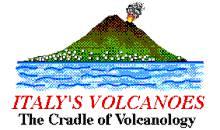|
WARNING:
Access to the summit area is DANGEROUS.
Eruptive activity at the summit craters is again increasing,
and sudden explosions that may drop pyroclastics (blocks and
bombs) are possible, especially at the SE Crater which has resumed
its episodic eruptive behavior. Besides this, weather conditions
are often unstable. The winter brings frequent snow storms and
clouds, and one gets easily lost due to the lack of points of
reference once there is a thick snow cover. One man was killed
in December 1999 when he fell into a chasm and dozens of people
have since then been reported lost and searched for, fortunately
without further tragic accidents. Excursions should be made
only with the mountain guides who can be contacted at the cable
car (near the Rifugio Sapienza) on the southern side of Etna,
or at the hotel "Le Betulle" at Piano Provenzana,
on the northern side.
|
6
February 2000 update.
Once more the SE Crater has been the source of a paroxysmal eruptive
episode. This latest event occurred early on 6 February, sometime
after 0430 h (local
time=GMT+1) and was similar to its predecessors, for its short duration
and the fracturing of the SE Crater cone during the climax of the
activity. A broad lava flow was emplaced on the southeastern (?) side
of the crater.
Besides these frequent paroxysms at the SE Crater, there is continuous
lava emission from a fracture on the northeastern slope of the SE
Crater cone, from which lava flows in surges, forming a lava field
composed of numerous overlapping and adjacent lobes. The flowing lava
has been visible from all over eastern Sicily at night during the
past few days and attracted many spectators. Eruptive activity is
also continuous in both vents of the Bocca Nuova, and reports in newspapers
and news agencies reflect the great confusion caused by this activity
in many locations on Etna's summit.
How interpret this new surge of activity at the summit craters, which
are in eruption since little less than 5 years? On the one hand, this
appears to be but the latest of many phases of increased activity
at one or more of these craters. Only four months ago the Bocca Nuova
produced spectacular and voluminous overflows of lava onto the western
flank of the volcano, which had not received any lava flow from the
summit craters since 35 years. One year ago, the SE Crater concluded
a series of 22 paroxysmal eruptive episodes with the opening of a
fracture on its southeastern flank. So there does not appear to be
much new in the current series of paroxysms. Yet there is: the tempo
of the SE Crater paroxysms is much faster than last winter, and there
is continuous slow lava effusion between the paroxysms, a phenomenon
not observed during the 1998-1999 series of paroxysms. And last but
least, when the SE Crater cone fractured on 4 February 1999, the magma
level in the Bocca Nuova dropped immediately, whereas the activity
in that crater does not appear to be affected appreciably by the current
activity at the SE Crater.
It should also be remembered that in September 1989, violent eruptive
episodes occurred twice a day at the SE Crater, and the latest of
those episodes were accompanied by the opening of eruptive fractures
on the southeastern and northeastern flanks of the SE Crater cone.
This activity eventually culminated in the formation of two large
fracture systems propagating southeastwards and northeastwards from
the SE Crater. The earlier fortunately did not produce any eruptive
activity, but the latter did, and only due to the short duration of
the flank activity no towns or cultivated areas were threatened by
the lava. The possibility that the increased SE Crater activity of
the last two weeks will be followed by more extensive fracturing at
lower elevation cannot be entirely excluded. It is, however, more
likely that Etna will continue to produce summit eruptions for some
time .
5
February 2000 update.
The SE Crater produced two further eruptive episodes on 5 February.
The first of these occurred shortly after midnight; like its predecessors,
it was preceded by a slow buildup of eruptive activity and its culminating
phase lasted only about 20 minutes. The event could be well observed
from Catania and other towns in the southern to eastern sectors of
the volcano.
At nightfall on 4 February,
lava was flowing from a vent located about two-thirds down the northeastern
flank of the SE Crater cone. The flow was only a few hundred meters
long and formed three branches. This effusive activity was observed
after dusk by Giuseppe Scarpinati (Italian correspondent of "L'Association
Volcanologique Européenne", L.A.V.E.), who lives in Acireale
and enjoys a panoramic view of the southeastern-eastern sector of
the volcano. Furthermore there was a persistent glow over the Bocca
Nuova, indicating Strombolian activity in one of its two vents (see
photos of these vents below, taken on 2 February).
The lava flow was well visible from Catania by 2000 h (local
time=GMT+1) on 4 February, and the lava output increased gradually
over the next four hours. Mild Strombolian activity began sometime
before 2330 from a vent high on the SSW flank, probably the same that
had erupted the small lava flow on the morning of 2 February. By this
time lava apparently spilled over the eastern rim of the crater. The
volume of lava running down the eastern flank increased, and explosive
activity at the summit vent (and possibly at the SSW flank vent) became
more and more vigorous. Shortly after 0010 h on
5 February the activity culminated with lava fountains and voluminous
lava emission. After only ten minutes the paroxysmal activity began
to diminish, although lava still moved down the eastern and SSW flanks.
The SSW flow appeared to be the more vigorous of the two lava flows.
Explosive activity was essentially over by 0030 h, but lava continued
to flow at a diminishing rate down the SSW flank. By 0100 h this flow
still had a few incandescent spots but apparently was no longer moving,
and the eruptive vents in the summit area of the SE Crater cone were
silent, but the Bocca Nuova continued with its relatively mild Strombolian
activity.
The second episode occurred shortly before noon, and its evolution
was probably similar to that of the previous episode. Lava was seen
flowing from a vent at the northeastern flank of the SE Crater cone
during the forenoon by Scarpinati, who observed rhythmic gas emissions
from the vent, possibly indicating minor explosive activity (spattering).
The ash produced by these latest eruptive episodes was blown by the
wind to the WSW, thus sparing again the skiing areas on the northern
and southern flanks of the volcano, which receive an intense flux
of skiers in these days characterized by marvellous weather conditions.
3
February 2000 update.
The SE Crater appears to go on erupting at increased pace. New eruptive
episodes - the fourth and the fifth in one week - have apparently
occurred during the morning of 2 February and again on the morning
of 3 February. The earlier event was reported in local newspapers
and probably occurred sometime between 0800 and 0830 h (local
time=GMT+1). Residents of Nicolosi reported to have heard loud explosions
and said that a light ash fall occurred in their village. A new eruptive
episode occurred this morning (3 February) sometime around 0830 h
and was observed by Giorgio De Guidi (Dipartimento di Scienze Geologiche,
University of Catania) from his home in Pedara, on the lower SE flank
of Etna. De Guidi reports that the crater emitted lava fountains and
a large eruption column, and then a fracture opened on its flank,
probably in the same location of the fracture that had been active
in the earlier eruptive episodes. The eruption from the fracture began
with an explosion in its upper part, and then a streak of white gas
appeared to run down along the fracture, forming an impressive plume.
This activity lasted only a few minutes, and then "everything
calmed, both the activity at the fracture and the explosions at the
summit" of the SE Crater cone.
| 2
February 2000 photos |
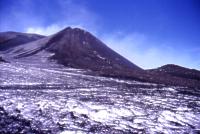 |
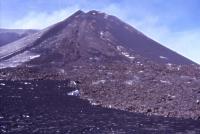 |
Southeast
Crater cone seen from south. The fissure which first opened
on 26 January 2000 is visible in the central part of the
cone, and a narrow lava flow erupted on the morning of 2
February is at left. The rounded knob at right is the vent
area where effusive activity occurred from early February
to late-August 1999
|
|
| A
closer look at the SE Crater cone from the southern margin
of the new lava field emplaced during the eruptive episodes
since 26 January. The new eruptive fracture is visible
slightly to the left of the image center; the 4 February
1999 fracture is to the right |
|
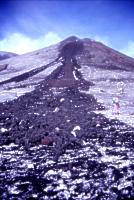 |
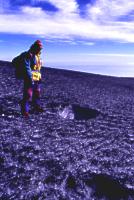 |
Looking
up the SSW flank of the SE Crater cone. Lava flow erupted
on the morning of 2 February is in the center. Snow melt
caused by the lava flow generated a very small lahar whose
deposit is visible in the foreground; another lahar is visible
at left
|
|
Impact
crater created when a block penetrated the snow at the base
of the SE Crater cone, about 400 m south of the crater.
Blocks were mainly ejected during the first eruptive episode
on 26 January when explosions shattered the uppermost part
of the cone
|
|
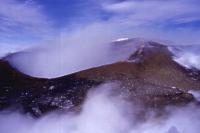 |
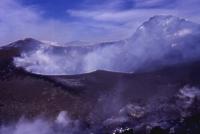 |
| The
northwestern vent of the Bocca Nuova is seen here from the
southern rim of the crater. The cone that had been built
in that place during the October-November 1999 activity
has largely collapsed into the widening vent |
|
| Eastern
vent of the Bocca Nuova seen from the same location. This
vent produced frequent Strombolian explosions and ash emissions
on 2 February, but is seen here in a quiet moment. All that
is left of a large cone formed in 1964 is visible at right |
|
The summit
area of Etna was visited on 2 February by Boris Behncke (Dipartimento
di Scienze Geologiche, University of Catania) and Giuseppe Scarpinati
(Italian correspondent of "L'Association Volcanologique Européenne",
L.A.V.E.). During the six hours of their visit, eruptive activity
occurred only at the Bocca Nuova whose southeastern vent produced
frequent Strombolian explosions and occasional sustained ash emissions.
The vent has actually shifted from its former location in the southeastern
part of the crater to the eastern portion of the crater. Many explosions
ejected incandescent bombs above the vent rim, but all fell back into
the vent. There was no visible activity at the northwestern vent which
had a broad cone around it. The Bocca Nuova, which had last been visited
by Behncke on 1 October 1999 (before the overflows of lava and the
vigorous eruptive activity of mid-October to early November 1999)
has changed beyond recognition. In its southwestern part the floor,
which is covered by October-November 1999 lava, stands at the elevation
of the western crater rim, and about 10 m below the southern crater
rim. The two vents in the eastern and northwestern parts of the crater
are large, with diameters of 100 m or more, respectively. A possible
collapse feature could be made out to the northwest of the northwestern
vent, but it could not be approached.
The SE Crater was silent. Its cone had undergone notable morphological
changes during the eruptive episodes of the past week, the most important
being the formation of the new fracture on its southern flank, which
lies aside the fracture of 4 February 1999. This fracture had emitted
most of the lava that had flowed southeastwards to the Valle del Bove.
High on the SSW flank of the SE Crater cone there was a small vent
which emitted bluish gas, and from which a narrow tongue of lava had
spilled to the base of the cone, cutting deeply into the snow and
causing very minor lahars. This flow, when sampled, was still hot,
and it may be that this flow was emplaced during the presumed eruptive
episode earlier that morning. The summit of the SE Crater cone appeared
to be a few meters higher than before the recent eruptive episodes,
its highest point lying on the western side of the crater. When seen
from the southeastern part of the former Central Crater, the summit
of the SE Crater cone stood only a few meters below the rim of the
former Central Crater (at about 3260 m elevation).
There is quite some mystery about glowing lava seen by Scarpinati
on the evening of 1 February, on the early morning of 2 February,
and on the evening of the same day. This lava apparently originated
from a spot somewhere below the SE Crater cone. During the 2 February
visit no flowing lava was seen near the cone, but the area located
to the north of the 1999 lava field was not visited, and there might
actually be a vent in that area which emitted lava also between eruptive
episodes. This mystery will be hopefully solved during another visit
to the area in the near future.
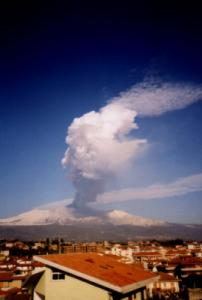 |
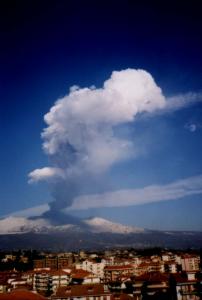 |
|
Eruptive
episode of 29 January 2000, seen from Acireale. These photos
were made by Giuseppe Scarpinati from his terrace.
|
1
February 2000 update.
This morning (1 February), a rain of small-sized lapilli fell on Catania
and surroundings, evidence of another eruptive episode at the SE Crater.
The lapilli are highly porous and the
largest fragments found in the central area of Catania were 0.4 cm
in diameter and 0.7 cm in length. The eruptive episode occurred sometime
after 0900 h (local time=GMT+1) and was extremely brief, like its
predecessor exactly three days earlier (29 January). It is not known
at present whether there was any outflow of lava.
This new eruptive episode is not surprising, and it appears that there
is a high regularity in the intervals between the episodes, like during
the series of 22 paroxysmal eruptions from the same crater between
September 1998 and February 1999.
If this regularity is maintained, then the next eruptive episode may
be expected sometime on Friday 4 February, to celebrate the anniversary
of the spectacular paroxysm which initiated the long-lived effusive
activity from vents at the SE base of the SE Crater cone.
A
series of other web pages covering the October-November eruptions
of the Bocca Nuova have recently posted; these contain photos and
movie clips of some of the most spectacular moments of that period.
A
photo gallery covering the period September-November 1999 (with photos
by Boris Behncke and Giuseppe Scarpinati)
Photos
of the eruptive activity, 26-31 October 1999, by Tom Pfeiffer (University
of Arhus, Denmark)
Photos
by Marco Fulle, 17-23 October 1999, at Stromboli On-line - Marco at
his best
Very
impressive video clips, taken by Roberto Carniel on 17-23 October
1999, at Stromboli On-line
Photos
by Juerg Alean, of 1 November 1999, at Stromboli On-line
Video
clips, taken by Juerg Alean on 1 November 1999, at Stromboli On-line
A
page by Charles Rivière, France, with many photos of the summer
and autumn of 1999 (in French)

visitors counted since 12 February 1999
(This page has received an incredible 4362
hits during the week of 24-30 October! - And, amazingly
enough, 4430 hits were counted
the week after.)
FastCounter
by LinkExchange
Page set up on 27 May 1997, last modified
on 6 February 2000
